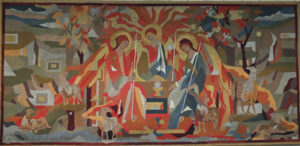
Our tapestry has been up for 18 years now. The trigger was when Holy Trinity’s reforming vicar Christopher Hewetson initiated the re-modelling of the altar area, when the old curtain that hung in front of the east window was swept away. The theme came from the art historian and HT’s curate at the time, the mercurial Elias Polomski, who re-created the classic three figures of Andrei Rublev’s Holy Trinity icon amid the fields and hills of Quarry and Shotover, with a scattering of Greek long-necked sheep. It was to take two years to complete.
Father Chris’ problem was: who were going to be the embroiderers? Volunteers weren’t queuing up so this dynamic man homed in on two young women who had joined the congregation only that day, Rachel and Mary Walding (now Podgorski). Would they accept the honour of doing some needlework on Holy Trinity’s new altarpiece?
Slightly bemused by the request but keen to become involved in church life, they agreed. Little did they realise that ‘helping’ would involve embroidering a third of the canvas (each) and several hundred hours’ work. Two years later, after they had devoted countless evenings and weekends to the work, bent over their separate tapestry frames among the coloured threads, the three pieces of completed canvas were ready to be sewn together. The frames were made by Alan Croft, Father Chris’ father-in-law. Marta Sykes matched the threads to the curate’s original painting and sourced them in Moreton-in-March..
However, before a stitch could be placed, a template had to be created. A professional in Cumbria, Helen Cain, charted the design life-size onto graph paper. Then Mary and Rachel Walding, and Mary Burr, another seamstress, each transferred the template onto their three pieces of canvas. The canvas was rolled onto each frame and stitching began in the house that the Waldings had barely moved in to and when they were still not fully unpacked. Mary knew how to sew and had a book of tapestry stitches; Rachel had always left sewing to her sister.
The work began with the tiny stitches along the top of the frame (petit point). Executed in monotonous brown and gold, with nothing happening in the picture, it couldn’t have been a more difficult start. The sisters worked two hours at a time, stooped over their two tilted frames until their backs hurt. Then came the creative stitching – twisted, looped and flat; laying down blocks of colour; counting and counting stitches. Patricia Hamilton-Smith, a very old lady who was desperate to be part of the project, put in a stitch on an angel’s wing.
Evening after evening for 15 months Mary and Rachel worked in what had become the Tapestry Room in the small Walding semi (‘We should have been out partying!’). Father Elias would swoosh by for tea in full clerical garb and cloak. Then they worked a further six months because the sewer of the central panel had left it unfinished. That was more fun. They had been creating fields and hills until then; now they had faces, heavenly rays of light, and wine (embroidered). The golden halos were a work of skill and love, though, because gold is hard to work. In the meantime, the congregation was either impatient or had lost interest: twenty months is a long wait.
When the longed for day finally arrived when the three panels were to be stitched together, there was a moment of horror. The trees, fields and swooping doves stitched onto the left and right panels didn’t match up with the angels in the centre piece. The sewers spent the next weekend on their knees with the tapestry on the floor of the Coach House, undoing and double-stitching, until they had put everything right. The completed tapestry was prepared for hanging by the Ladies Work Society of Moreton-in-Marsh and dedicated by the Bishop of Oxford on 17 July 1994. Its warm colours contrast with the fresh tints of the Ascension window above.
It had been a leap of faith for Father Chris to ask these two eager unknowns to take on the job. The two young women were conscious how many eyes would be gazing at their work and that objects in churches survive for centuries. Of those evenings stitching haloes and long-necked sheep, they say, ‘It’s still so fresh in our memories’.
